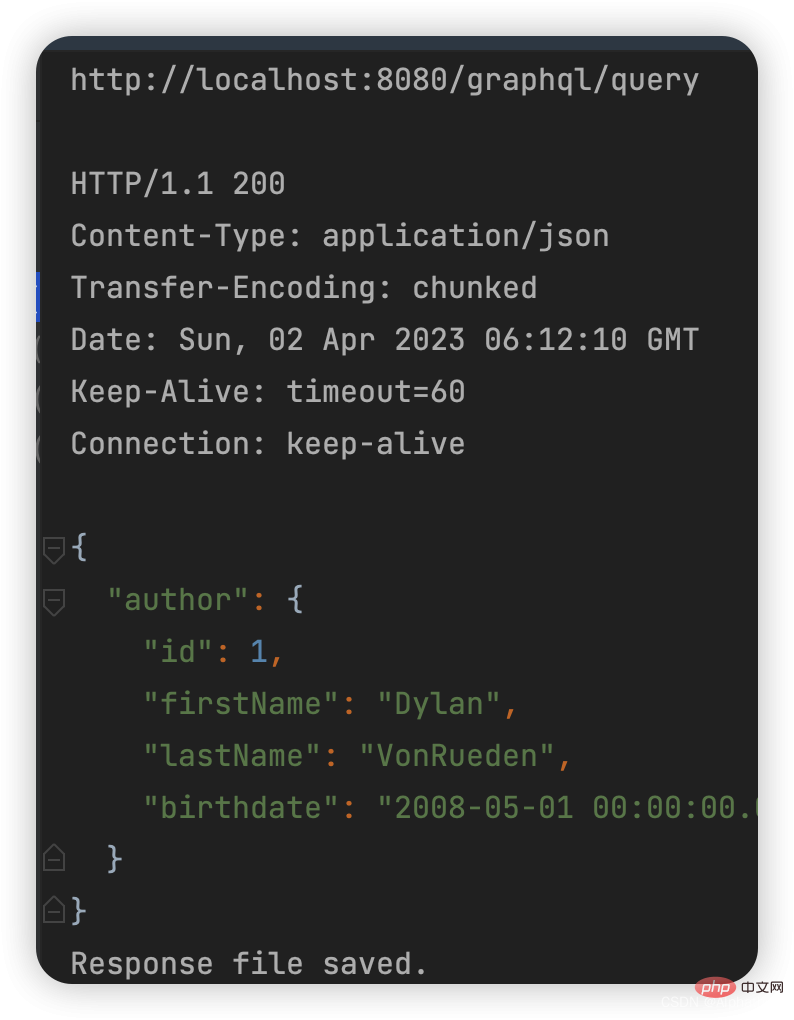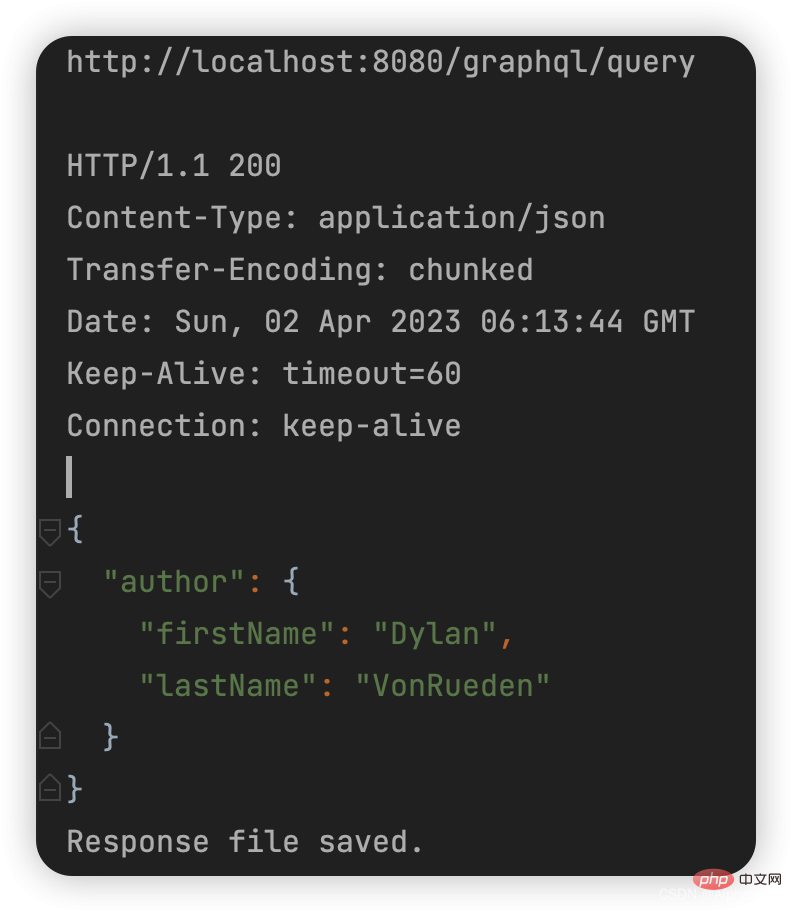How SpringBoot uses GraphQL to develop Web API
Preface
The traditional Restful API has many problems. First of all, it cannot control the fields returned, and the front-end cannot predict the return results of the back-end. In addition, different return results correspond to different request addresses. This is This resulted in multiple requests. GraphQL is an API query language built based on this background. Compared with traditional Restful API, it has the following advantages:
Flexibility: GraphQL can be flexible according to the needs of the client. Query data efficiently instead of returning fixed-structured data like RESTful API.
Reduce network requests: GraphQL allows clients to obtain multiple resources in a single request, which helps reduce the number of network requests and improve performance.
Strong typing: GraphQL has a strongly typed system that allows clients to detect errors in queries at compile time, which helps reduce runtime errors.
Cacheable: GraphQL is cacheable, which means the server can cache the results of a query, improving performance and scalability.
Documentation: GraphQL has the ability to self-document, allowing developers to quickly understand the structure and functions of the API.
Implementation plan of GraphQL in Spring Boot
If the back-end language is Java, then GraphQL Java is the basic library for implementing GraphQL. In addition, Spring has integrated GraphQL. If Spring is used in the project, Spring GraphQL is more recommended.
The development of Spring GraphQL is generally divided into the following steps
Add Spring GraphQL dependencies
Add Spring GraphQL dependencies in your project. You can add dependencies through build tools like Maven or Gradle. For example, if you use Maven, you can add the following dependency
<dependency>
<groupId>org.springframework.boot</groupId>
<artifactId>spring-boot-starter-graphql</artifactId>
</dependency>Define GraphQL Schema
Define GraphQL Schema in your application. Schema defines queryable types and fields. You can define a schema using SDL (Schema Definition Language) or programmatically.
For the Spring Boot project, the schema file is placed in the resources/graphql/ directory, and the file name is suffixed with graphqls. The following is a simple schema.graphqls that I defined.
It specifies two query implementations. author(id:Int) means querying the Author by id, and allAuthors means querying the Author array.
schema {
query: Query
}type Query {
author(id:Int): Author
allAuthors: [Author]
}type Author {
id:Int
firstName:String
lastName:String
email:String
birthdate:String
}
Implementing RuntimeWiringConfigurer
RuntimeWiringConfigurer is the core of implementing GraphQL to obtain data. Using GraphQL cannot directly remove persistence layer frameworks such as Mybatis/Jpa. Obtaining data from the database still requires the support of such frameworks.
The RuntimeWiringConfigurer is similar to the service layer in Spring, which is the core of implementing basic data.
The following is a simple example:
@Component
public class AuthorWiring implements RuntimeWiringConfigurer {
private final AuthorRepository authorRepository;
public AuthorWiring(AuthorRepository authorRepository) {
this.authorRepository = authorRepository;
}
@Override
public void configure(RuntimeWiring.Builder builder) {
builder.type("Query", typeWiring -> typeWiring
.dataFetcher("allAuthors", environment -> authorRepository.findAll())
.dataFetcher("author", environment -> authorRepository.getReferenceById(environment.getArgument("id")))
}
}Here, two DataFetcher objects are defined inside the configure method to specify how author and allAuthors query data. It can be seen that JPA is still used to query data. Query data.
Define GraphQL Controller
We define GraphQLController to receive the input parameters of web requests. The example is as follows:
@RestController
@RequestMapping("graphql")
public class GraphQLController {
private final GraphQL graphQL;
@Autowired
public GraphQLController(GraphQlSource graphQlSource) {
graphQL = graphQlSource.graphQl();
}
@PostMapping("query")
public ResponseEntity<Object> query(@RequestBody String query) {
ExecutionResult result = graphQL.execute(query);
return ResponseEntity.ok(result.getData());
}
}The GraphQL object in the code is the entrance to execute the query, but GraphQL There is only one private constructor, so it cannot be injected directly. You must obtain the GraphQL object by injecting GraphQlSource.
Note that in GraphQL we can only use String to receive parameters, and cannot use model objects. This is because the Graph request parameters are not json structures.
Test Graph request
We create a graphql.http file to perform http requests in idea
}Content-Type: application/json
Send POST request with json body
POST http://localhost:8080/graphql/query}
{
author(id: 1) {
id
firstName
lastName
birthdate
}POST http://localhost:8080/graphql/query
Send POST request with json bodyContent -Type: application/json
}
{
allAuthors {
id
firstName
lastName
birthdate
Run the query for author(id: 1) and you can see that the results are returned normally. If we only need the firstName and lastName fields, then just remove the id and birthdate from the request input parameters without changing any back-end code. 

The above is the detailed content of How SpringBoot uses GraphQL to develop Web API. For more information, please follow other related articles on the PHP Chinese website!

Hot AI Tools

Undresser.AI Undress
AI-powered app for creating realistic nude photos

AI Clothes Remover
Online AI tool for removing clothes from photos.

Undress AI Tool
Undress images for free

Clothoff.io
AI clothes remover

AI Hentai Generator
Generate AI Hentai for free.

Hot Article

Hot Tools

Notepad++7.3.1
Easy-to-use and free code editor

SublimeText3 Chinese version
Chinese version, very easy to use

Zend Studio 13.0.1
Powerful PHP integrated development environment

Dreamweaver CS6
Visual web development tools

SublimeText3 Mac version
God-level code editing software (SublimeText3)

Hot Topics
 Comparison and difference analysis between SpringBoot and SpringMVC
Dec 29, 2023 am 11:02 AM
Comparison and difference analysis between SpringBoot and SpringMVC
Dec 29, 2023 am 11:02 AM
SpringBoot and SpringMVC are both commonly used frameworks in Java development, but there are some obvious differences between them. This article will explore the features and uses of these two frameworks and compare their differences. First, let's learn about SpringBoot. SpringBoot was developed by the Pivotal team to simplify the creation and deployment of applications based on the Spring framework. It provides a fast, lightweight way to build stand-alone, executable
 How to crawl and process data by calling API interface in PHP project?
Sep 05, 2023 am 08:41 AM
How to crawl and process data by calling API interface in PHP project?
Sep 05, 2023 am 08:41 AM
How to crawl and process data by calling API interface in PHP project? 1. Introduction In PHP projects, we often need to crawl data from other websites and process these data. Many websites provide API interfaces, and we can obtain data by calling these interfaces. This article will introduce how to use PHP to call the API interface to crawl and process data. 2. Obtain the URL and parameters of the API interface. Before starting, we need to obtain the URL of the target API interface and the required parameters.
 React API Call Guide: How to interact and transfer data with the backend API
Sep 26, 2023 am 10:19 AM
React API Call Guide: How to interact and transfer data with the backend API
Sep 26, 2023 am 10:19 AM
ReactAPI Call Guide: How to interact with and transfer data to the backend API Overview: In modern web development, interacting with and transferring data to the backend API is a common need. React, as a popular front-end framework, provides some powerful tools and features to simplify this process. This article will introduce how to use React to call the backend API, including basic GET and POST requests, and provide specific code examples. Install the required dependencies: First, make sure Axi is installed in the project
 Save API data to CSV format using Python
Aug 31, 2023 pm 09:09 PM
Save API data to CSV format using Python
Aug 31, 2023 pm 09:09 PM
In the world of data-driven applications and analytics, APIs (Application Programming Interfaces) play a vital role in retrieving data from various sources. When working with API data, you often need to store the data in a format that is easy to access and manipulate. One such format is CSV (Comma Separated Values), which allows tabular data to be organized and stored efficiently. This article will explore the process of saving API data to CSV format using the powerful programming language Python. By following the steps outlined in this guide, we will learn how to retrieve data from the API, extract relevant information, and store it in a CSV file for further analysis and processing. Let’s dive into the world of API data processing with Python and unlock the potential of the CSV format
 Oracle API integration strategy analysis: achieving seamless communication between systems
Mar 07, 2024 pm 10:09 PM
Oracle API integration strategy analysis: achieving seamless communication between systems
Mar 07, 2024 pm 10:09 PM
OracleAPI integration strategy analysis: To achieve seamless communication between systems, specific code examples are required. In today's digital era, internal enterprise systems need to communicate with each other and share data, and OracleAPI is one of the important tools to help achieve seamless communication between systems. This article will start with the basic concepts and principles of OracleAPI, explore API integration strategies, and finally give specific code examples to help readers better understand and apply OracleAPI. 1. Basic Oracle API
 Oracle API Usage Guide: Exploring Data Interface Technology
Mar 07, 2024 am 11:12 AM
Oracle API Usage Guide: Exploring Data Interface Technology
Mar 07, 2024 am 11:12 AM
Oracle is a world-renowned database management system provider, and its API (Application Programming Interface) is a powerful tool that helps developers easily interact and integrate with Oracle databases. In this article, we will delve into the Oracle API usage guide, show readers how to utilize data interface technology during the development process, and provide specific code examples. 1.Oracle
 How to deal with Laravel API error problems
Mar 06, 2024 pm 05:18 PM
How to deal with Laravel API error problems
Mar 06, 2024 pm 05:18 PM
Title: How to deal with Laravel API error problems, specific code examples are needed. When developing Laravel, API errors are often encountered. These errors may come from various reasons such as program code logic errors, database query problems, or external API request failures. How to handle these error reports is a key issue. This article will use specific code examples to demonstrate how to effectively handle Laravel API error reports. 1. Error handling in Laravel
 How to develop a simple CRUD API using MongoDB
Sep 19, 2023 pm 12:32 PM
How to develop a simple CRUD API using MongoDB
Sep 19, 2023 pm 12:32 PM
How to use MongoDB to develop a simple CRUD API In modern web application development, CRUD (Create, Delete, Modify, Check) operations are one of the most common and important functions. In this article, we will introduce how to develop a simple CRUD API using MongoDB database and provide specific code examples. MongoDB is an open source NoSQL database that stores data in the form of documents. Unlike traditional relational databases, MongoDB does not have a predefined schema






